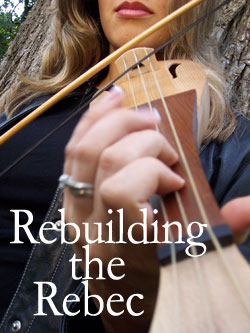Building a Medieval Rebec
I bought two different rebecs on ebay that are commonly available. The production of early instruments in Pakistan, Egypt, and other countries has made them very affordable for musicians. Some of them are quite nice and some of them are nothing more than wall-hangings, completely unplayable.
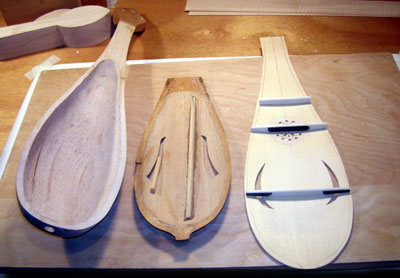 The rebecs that are sold by several different companies seem to be exactly the same, right down to the case and bow. They can be nice instruments, but they vary greatly from one to the other in sound quality, as might be expected. One of the rebecs we bought on ebay had a bright, clear sound, without much volume. The other was so quiet that it was practically inaudible. This is the one I chose to rebuild. The rebecs that are sold by several different companies seem to be exactly the same, right down to the case and bow. They can be nice instruments, but they vary greatly from one to the other in sound quality, as might be expected. One of the rebecs we bought on ebay had a bright, clear sound, without much volume. The other was so quiet that it was practically inaudible. This is the one I chose to rebuild.
Taking the instrument apart, I discovered that it had a bass bar and soundpost, like a modern violin. Although medieval instrument makers might have carved an arched top, I'm certain they would not have included a bass bar. Had they made a simple flat top, it would have had a couple of transverse bars to keep it from collapsing, exactly like the lute. I decided to make a new top along the lines of Italian bent-top viols or early lutes--a thin plate with a few transverse bars. I gave a small amount of curvature to the bars just to help stiffen up the top and keep it from sagging inward under string pressure. Flat tops and thin tops may also require that you jam a small stick underneath the bridge to keep the top from collapsing. This looks suspiciously like a soundpost, and I suspect it led to the development of the soundpost in the violin.
The result was an instrument with much more volume than either of the rebecs. It still had the thin, nasal sound one would expect from a rebec, but it was just a bit sweeter than before. I also included a little medieval-style rosette with four-fold symmetry, which can be seen in late Medieval/early Renaissance depictions of rebecs.
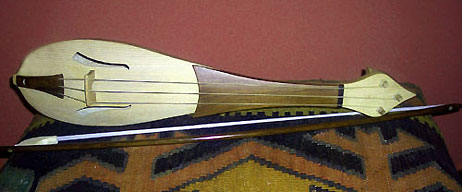 Before (top) and after (bottom) photos of the rebec. I added a little rosette, which is often seen in ancient paintings and statues depicting rebecs. Before (top) and after (bottom) photos of the rebec. I added a little rosette, which is often seen in ancient paintings and statues depicting rebecs.
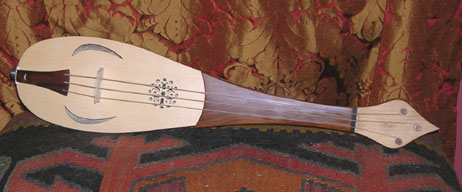 In the absence of surviving instruments, I think you can still build something similar to what they had in the Middle Ages. All you have to do is use the tools and materials available to craftsmen in the Middle Ages and forget everything you know about modern violin construction. It also helps if you have built medieval lutes or early viols. It's mainly a matter of avoiding the supposition that musical instruments evolved and that something that came later was an improvement. In most cases changes in instrument design and construction were mainly a result of changes in music, style, taste, and the demands of musicians. Musical instruments did not evolve in the sense that improvements in construction techniques, glues, and other technological advances caused immediate changes in instrument design. It is notable that when wound strings were developed (strings overspun with metal windings), musicians resisted them for nearly 100 years. In the world of musical instruments, something that came later is not better, just different. In the absence of surviving instruments, I think you can still build something similar to what they had in the Middle Ages. All you have to do is use the tools and materials available to craftsmen in the Middle Ages and forget everything you know about modern violin construction. It also helps if you have built medieval lutes or early viols. It's mainly a matter of avoiding the supposition that musical instruments evolved and that something that came later was an improvement. In most cases changes in instrument design and construction were mainly a result of changes in music, style, taste, and the demands of musicians. Musical instruments did not evolve in the sense that improvements in construction techniques, glues, and other technological advances caused immediate changes in instrument design. It is notable that when wound strings were developed (strings overspun with metal windings), musicians resisted them for nearly 100 years. In the world of musical instruments, something that came later is not better, just different.
 The bow that comes with the ebay rebec has white plastic "hair" (shown in the top rebec photo). I made a whole new bow using black horse hair (at left). Black horse hair is courser than white hair and produces more sound from the instrument. It is still used today in many folk cultures. The bow that comes with the ebay rebec has white plastic "hair" (shown in the top rebec photo). I made a whole new bow using black horse hair (at left). Black horse hair is courser than white hair and produces more sound from the instrument. It is still used today in many folk cultures.
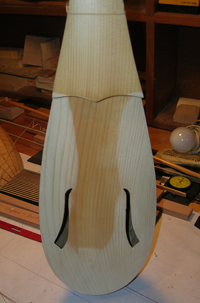 Here's another one of the middle eastern rebecs that I was able to improve. The sound of this rebec was extremely constrained--very tight and nasal. By removing half of the soundboard thickness (in the lighter areas) and just a little in the middle, the sound was improved far beyond my expectations. This rebec is now less nasal, sweeter, and just a little louder. The original soundboard was about 4-5mm thck overall. I took the edges down to 2mm and the middle area (the darker area) down to about 3mm. Since the instrument had a soundpost, the soundboard shouldn't collapse. Here's another one of the middle eastern rebecs that I was able to improve. The sound of this rebec was extremely constrained--very tight and nasal. By removing half of the soundboard thickness (in the lighter areas) and just a little in the middle, the sound was improved far beyond my expectations. This rebec is now less nasal, sweeter, and just a little louder. The original soundboard was about 4-5mm thck overall. I took the edges down to 2mm and the middle area (the darker area) down to about 3mm. Since the instrument had a soundpost, the soundboard shouldn't collapse.
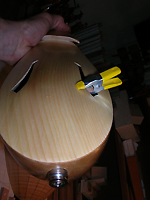 Since we often play in noisy bars, I fitted this rebec with a pickup. Note the quarter-inch endpin jack. The little clamp was used to glue the piezo-electric disc on the underside of the soundboard. This may now be the loudest rebec in the known Universe. Note: These little piezo discs work quite well on bowed-string instruments, less well on plucked-string instruments. Since we often play in noisy bars, I fitted this rebec with a pickup. Note the quarter-inch endpin jack. The little clamp was used to glue the piezo-electric disc on the underside of the soundboard. This may now be the loudest rebec in the known Universe. Note: These little piezo discs work quite well on bowed-string instruments, less well on plucked-string instruments.
| 
